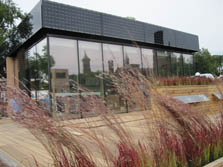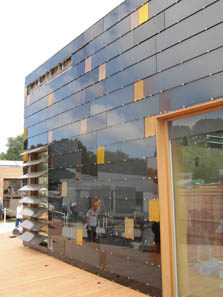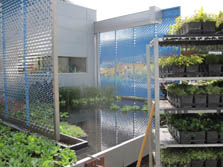
Click photo to view high-resolution image.

Tall grass lines the deck of Team Ontario/BC's North House. Custom PV panels line the top of the structure.
(Credit: Annie Coghill/U.S. Department of Energy Solar Decathlon)

A closer view of the Team Germany house reveals solar panels interspersed with colored plexiglass.
(Credit: Annie Coghill/U.S. Department of Energy Solar Decathlon)

Virginia Tech's Lumenhaus is aptly named for the light that flows through the architectural features, including these laser-cut screens, part of a moveable wall system.
(Credit: Annie Coghill/U.S. Department of Energy Solar Decathlon)
Solar Decathlon 2009
Daily Journal - October 6, 2009
Emerging Technologies Define Solar Decathlon
It's nail-biting time as teams wrap up the construction process. Sixteen teams have passed all of their electrical inspections and are now connected with the grid and operating their houses from PV systems. Only four teams—Team Spain, Puerto Rico, Penn State, and Wisconsin-Milwaukee—need further work before their houses can be connected.
All houses must be grid-connected by 2 p.m. tomorrow, with assembly completed and lots cleaned by 5 p.m. That gives teams less than 24 hours to finish. Most teams remain upbeat, but you can sense a quickness to the pace and a sense of urgency from others. A look at the time-lapse camera may give the impression that a huge amount of work remains, but you'll be surprised how fast things will come together tomorrow afternoon.
The solar village is like one big puzzle with highly innovative pieces. As they are fitted together and nearing completion, we learn more about what makes each house special.
Team Ontario/BC's innovative PV modules got a stamp of approval just yesterday for use in North America from a nationally recognized testing lab that evaluated their viability, performance, safety, and integration. These one-of-a-kind, high-efficiency PV modules are designed for the upper portions of the east, west, and south sides of the house.
Team Germany, defending champions from 2007, created a two-story cube with a façade made of thin-film PV modules and colored plexiglass that envelop the entire house—even the north side. The thin-film material allows for custom fitting, an important aspect for integrating PV into an existing structure. Testing so far shows the façade generates 30% to 40% of the house's power. The rest is generated from horizontal panels on the roof of the house.
The Virginia Tech entry, Lumenhaus, is another high-tech marvel. Movable wall systems make it instantly recognizable. Sliding polycarbonate doors filled with Nanogel can be opened or closed for heat gain or loss. The panels and shading screens perform a large portion of the heating and cooling functions through passive design. When fully open, they create a pavilion-style living space that blends with the outdoors. Another feature of Lumenhaus is its concrete flooring. Specially developed for the Solar Decathlon, the concrete is integrated with a flexible material that makes the flooring lighter and easier to transport, opening up all kinds of opportunities for modular homebuilders.
Amidst all the technology highlights is a different kind of forward-thinking from the Iowa State team. Its Interlock House meets the needs of seniors who want to live independently and sustainably. Everything—including the cabinets, kitchen layout, and bedroom, which features a custom Murphy bed with assisted lowering—is 100% accessible under ADA (Americans With Disabilities Act) requirements. A roll-in, zero-threshold shower in a large bathroom allows for full wheelchair movement. The Iowa State team hopes its design will appeal to retirees who want to age "in place."
